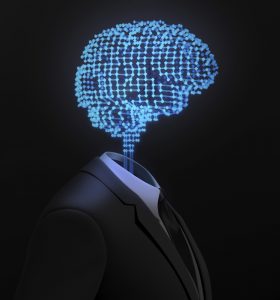 We have entered the “second machine age.” The first machine age began with the industrial revolution, which was driven primarily by technology innovation. The ability to generate massive amounts of mechanical power made humans more productive. Where the steam engine started the industrial revolution, the second machine age has taken us by storm with computers and other digital advancements giving us the ability to understand and shape our environments. What the steam engine and its descendants did for muscle power, the Internet of Things (IoT), computers, digital technology, artificial intelligence (AI) and machine learning (ML) will do for brainpower.
We have entered the “second machine age.” The first machine age began with the industrial revolution, which was driven primarily by technology innovation. The ability to generate massive amounts of mechanical power made humans more productive. Where the steam engine started the industrial revolution, the second machine age has taken us by storm with computers and other digital advancements giving us the ability to understand and shape our environments. What the steam engine and its descendants did for muscle power, the Internet of Things (IoT), computers, digital technology, artificial intelligence (AI) and machine learning (ML) will do for brainpower.
The new analytics economy
Emerging out of the second machine age is the new analytics economy. The key to the analytics economy is data, analytics and collaboration. But the collaboration will be between humans and machines. Machines will automate the mundane, labor-intensive work, and allow humans to work smarter to uncover insights and make faster real-time decisions based on digital information streaming from connected devices.
What really defines the analytics economy is the acceptance and pervasiveness of embedded analytics. In this new economy each insight sparks the next insight and then these insights compound, just like our financial investments. The analytics economy will bring a new era of change, which will be incremental in some cases, but it will also be transformative.
The transformation will be across the board from technology, to business processes, to new aspects of industry that we haven't seen yet. Now is the time to capitalize on the analytics economy, and implementing a best-in-class analytics platform is vital. You need a platform that allows you to quickly create value from your data by seamlessly moving through the analytics lifecycle, perfecting the path from data to decisions.
Four key disruptions
Over the past decade, consumers have been gaining power and control over the purchasing process. Unprecedented amounts of information and new digital technologies have enabled more control, and instead of calling the shots, marketers have found themselves dodging bullets. However, in the last three years there’s been a shift. Even as customers continue to exert unprecedented control of purchasing decisions, power is swinging back toward marketers, with the help from technology and analytics that play a new and larger role in the middle.
Consumers are turning increasingly to technology to help them make decisions. This has been enabled by four key disruptions.
- Automated consumer engagement: A shift from active engagement to "automated engagement” where technology takes over tasks from information gathering to actual execution.
- Digital technologies: An expanding IoT which embeds sensors almost anywhere to generate smart data on consumer preferences and trigger actions and offers by marketers.
- Predictive analytics: Improved predictive analytics or "anticipatory" technology that can accurately anticipate what consumers want or need before they even know it – based not just on past behavior but on real-time information and availability of alternatives that could alter consumer choices.
- Faster more powerful computers: The availability of faster and more powerful software that crunches petabytes of data, filters it through super-sophisticated models and helps marketers gain previously unheard-of efficiencies and make highly targeted offers.
It’s not merely about predicting what consumers want. It’s about anticipating – which includes the more sophisticated ability to adapt marketing offers and messages to alternatives based on data from hundreds of possible sources. By anticipating, we gain a greater chance of influencing outcomes. Consumer's phones or smartwatches can deliver recommendations and offers of where to go, how to get there and what to buy based on what they are about to do, not just what they’ve done in the past.
Anticipation is about the short-term future, or even a specific day and time. Analytics provides marketers with the ability to create contextual engagements with their customers by delivering personalized, real-time responses.
Technology is helping both marketers and customers take the next evolutionary step. Instead of merely empowering customers, it's making decisions and taking action for them. Analytics technology will be doing more and more of the work for companies by automating activities around research or making actual purchases.
Advances in AI and ML
The impressive advances in artificial intelligence and machine learning over the past decade are supported by supervised deep learning: training ML algorithms to perform narrow, single-domain tasks. The learning is supervised because you're telling the algorithm the correct answer (the label) as it is exposed to many examples using big data.
We're now seeing unsupervised learning systems that learn faster, require less data, and achieve impressive performance. These supervised and unsupervised intelligent automation techniques can help experts achieve automation and enrich their domain expertise, helping them work more effectively (not replace them).
Intelligent automation techniques can be applied to all kinds of activities across your organization to reduce the daily repetitive work while uncovering key insights to improve the effectiveness of your processes, as well as your workforce.
Intelligent automation driven by AI and ML
The rapid deployment of intelligent automation is helping us set new standards of efficiency, speed, and functionality. Instead of being replaced, humans will see unprecedented job creation, as well as new opportunities to add more value. The following statement by SAS COO Oliver Schabenberger sums up the situation.
The challenge is people have not developed the level of trust in artificial intelligence and machine learning that they have in other technologies that automate tasks. People sometimes confuse automation with autonomy.
For more information regarding real-time meaningful customer interactions click here for a free white paper: Maximizing Moments of Truth.

